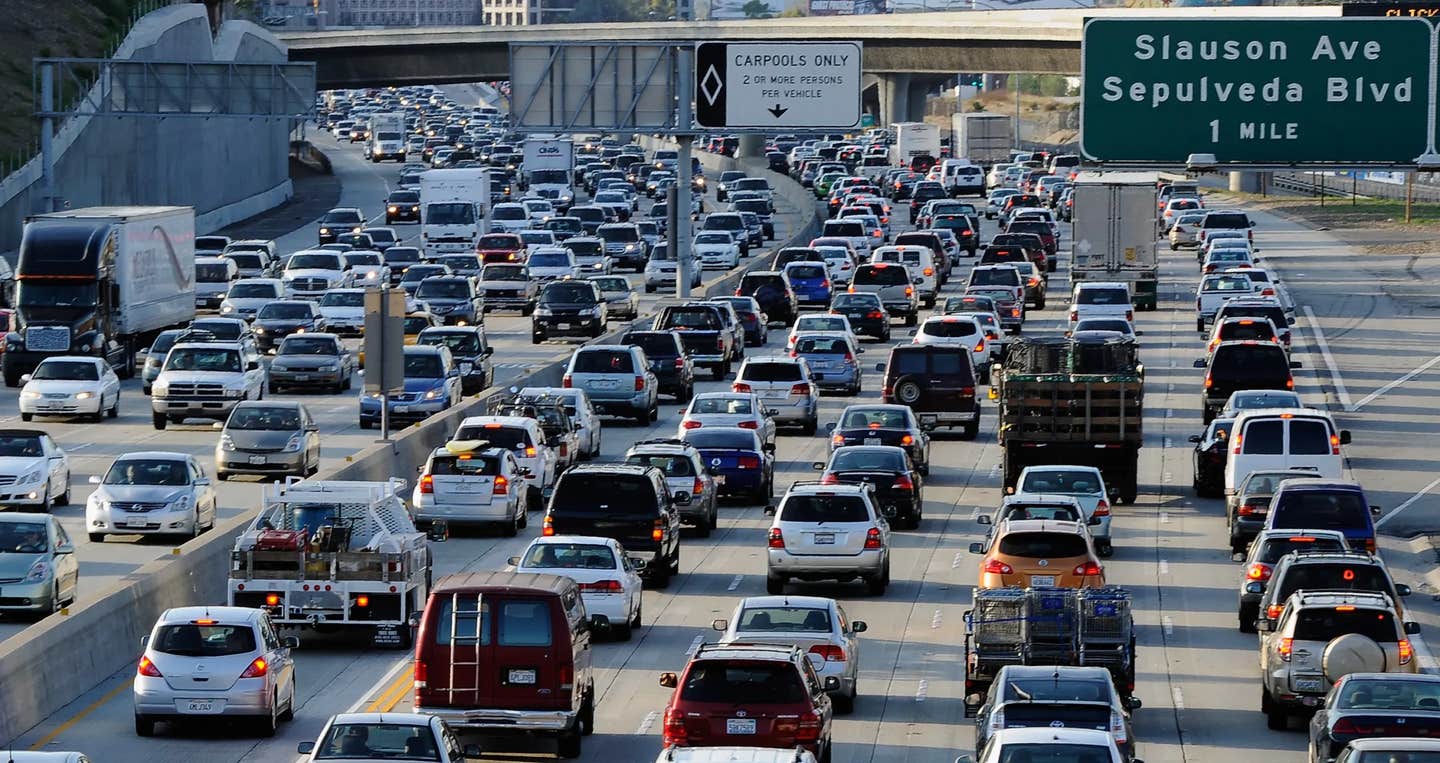Breathing air in rush-hour traffic linked to elevated blood pressure
Highways and wide arterials have come to define metropolitan areas, but they also bring a less visible but insidious problem: air pollution

[Nov. 28, 2023: JD Shavit, The Brighter Side of News]
For over a century, American cities have grappled with the omnipresence of high-traffic roadways that crisscross their landscapes. (CREDIT: KTLA)
For over a century, American cities have grappled with the omnipresence of high-traffic roadways that crisscross their landscapes. These vast networks of interstate highways and wide arterials have come to define metropolitan areas, but they also bring a less visible but insidious problem: air pollution.
As researchers delve deeper into the long-term effects of traffic-related air pollution, a complex blend of exhaust emissions, brake and tire wear, and road dust, they are uncovering a disturbing correlation with serious health issues. From cardiovascular disease to asthma, lung cancer, and even premature death, the consequences of breathing in this toxic cocktail are becoming increasingly evident.
A recent study conducted by the University of Washington sheds light on yet another facet of this issue. Published in the Annals of Internal Medicine, the research reveals that even passengers traveling along busy roads are not immune to the health risks posed by traffic-related air pollution.
In a groundbreaking investigation, the study demonstrates that exposure to unfiltered air during rush-hour traffic can significantly elevate blood pressure levels, both during the journey and for up to 24 hours afterward. This revelation has prompted a closer examination of the intricate relationship between air pollution and human health.
Related Stories:
"The body has a complex set of systems to try to keep blood pressure to your brain the same all the time. It’s a very complex, tightly regulated system, and it appears that somewhere, in one of those mechanisms, traffic-related air pollution interferes with blood pressure," explains Joel Kaufman, a physician and professor of environmental and occupational health sciences at the University of Washington, who led the study.
Kaufman's previous research had already indicated that exposure to diesel exhaust fumes could raise blood pressure levels under controlled conditions. To further investigate this phenomenon in a real-world setting and isolate the effects of traffic-related air pollution, the researchers embarked on a unique experiment involving healthy participants aged 22 to 45.
During the study, participants were driven through Seattle's congested rush-hour traffic while their blood pressure was meticulously monitored. The experiment consisted of three separate drives: on two of them, participants were exposed to unfiltered road air, simulating the conditions many commuters face daily. On the third drive, the vehicle was equipped with high-quality HEPA filters capable of blocking out 86% of particulate pollution. Crucially, participants remained unaware of whether they were experiencing a drive with clean or polluted air.
Seattle's congested rush-hour traffic. (CREDIT: Creative Commons)
The results were striking. Breathing unfiltered air led to a net increase in blood pressure of more than 4.50 mm Hg (millimeters of mercury) compared to drives with filtered air. This elevation occurred rapidly, peaking approximately one hour into the journey and persisting for at least 24 hours. The magnitude of this increase is comparable to the effect of a high-sodium diet.
"We know that modest increases in blood pressure like this, on a population level, are associated with a significant increase in cardiovascular disease,” Kaufman emphasizes. “There is a growing understanding that air pollution contributes to heart problems. The idea that roadway air pollution at relatively low levels can affect blood pressure this much is an important piece of the puzzle we’re trying to solve.”
The study's findings also raise intriguing questions about ultrafine particles, a poorly regulated and little-understood pollutant. (CREDIT: Creative Commons)
The study's findings also raise intriguing questions about ultrafine particles, a poorly regulated and little-understood pollutant that has garnered increasing attention from public health experts. These particles, with diameters of less than 100 nanometers, are too small to be seen by the naked eye and are present in high concentrations in traffic-related air pollution.
"Ultrafine particles are the pollutant that were most effectively filtered in our experiment – in other words, where the levels are most dramatically high on the road and low in the filtered environment,” Kaufman notes. “So, the hint is that ultrafines may be especially important [for blood pressure]. To actually prove that requires further research, but this study provides a very strong clue as to what’s going on.”
Michael Young, the lead author of the study and a former postdoctoral fellow in the Department of Environmental and Occupational Health Sciences at the University of Washington. (CREDIT: University of Washington)
Air Quality Disparities Across Metropolitan Areas
One of the study's crucial findings underscores the role of traffic-related air pollution as the primary cause of air quality variation between different communities in most U.S. metropolitan areas. The consequences of this pervasive issue are not only health-related but also affect the quality of life and well-being of residents in these areas.
Michael Young, the lead author of the study and a former postdoctoral fellow in the Department of Environmental and Occupational Health Sciences at the University of Washington, highlights the significance of their research approach. "This study is exciting because it takes the gold-standard design for laboratory studies and applies it in an on-roadway setting, answering an important question about the health effects of real-world exposures.
Studies on this topic often have a challenging time separating the effects of pollution from other roadway exposures like stress and noise, but with our approach the only difference between drive days was air pollution concentration,” he explains. “The findings are valuable because they can reproduce situations that millions of people actually experience every day.”
The study underscores the urgent need for continued research and comprehensive measures to mitigate the impact of traffic-related air pollution on public health. It also emphasizes the importance of policies aimed at reducing emissions and improving air quality, particularly in densely populated metropolitan areas.
As we strive to solve the puzzle of the health risks associated with traffic-related air pollution, one thing remains clear: the health and well-being of commuters and urban residents depend on our ability to address this pervasive and insidious problem in the years to come.
For more science and technology stories check out our New Discoveries section at The Brighter Side of News.
Note: Materials provided above by University of Zurich. Content may be edited for style and length.
Like these kind of feel good stories? Get the Brighter Side of News' newsletter.



